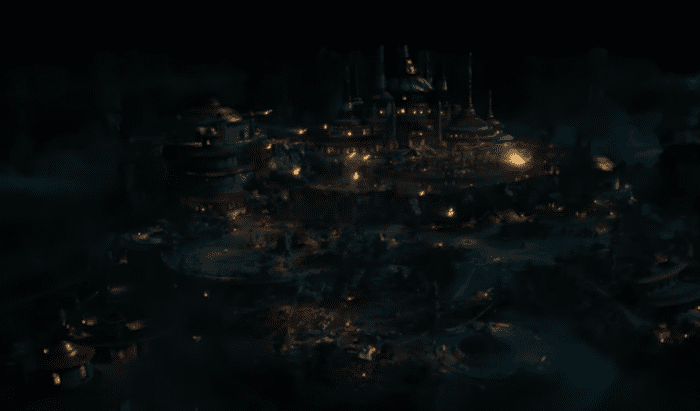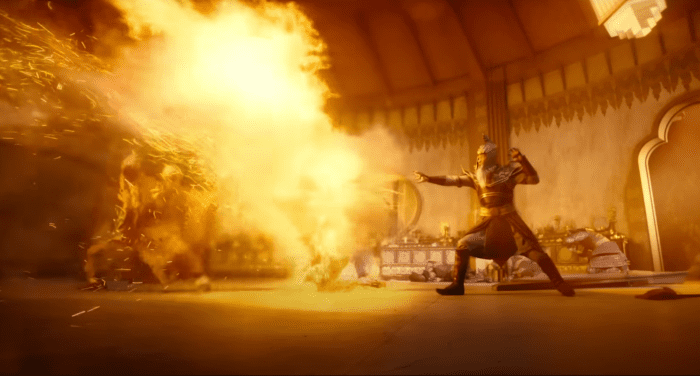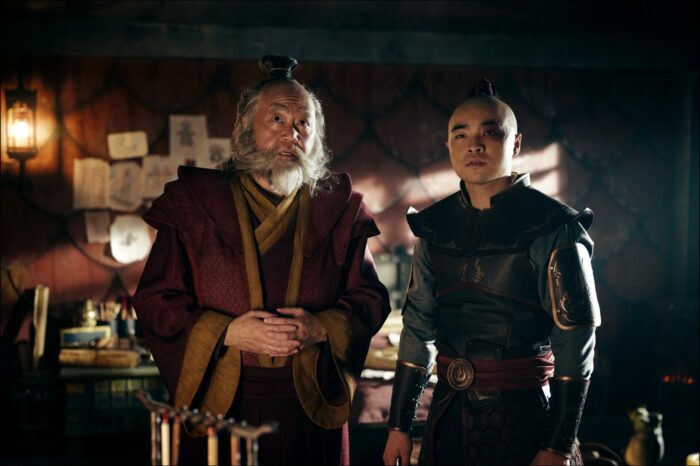The following contains spoilers for the premiere of Netflix’s live-action Avatar: The Last Airbender, S1E1, “Aang” (written by Albert Kim, Michael Dante DiMartino & Bryan Konietzko, and directed by Michael Goi)
The new live-action version of Avatar: The Last Airbender released on Netflix yesterday, finally offering an answer to the question fans of the original cartoon have been asking since it was announced: Will this adaptation actually be watchable? The answer thankfully is not only yes, but more than that—this adaptation is actually… good.
That may seem like faint praise for a project with this much time, effort, and money put into it, but that is far far better than most fans of the show expected. (Once you have one of the worst movies of all-time made out of one of your favorite shows, expectations are tempered a bit.) Even though original series creators Michael Dante DiMarino & Bryan Konietzko left this project due to “creative differences” with Netflix, their input in the initial stages is still evident in the finished product (and they both still have writing credits on a couple episodes.)
Albert Kim, who took over as showrunner after they left, continued the dedication to authenticity in casting and production design, which certainly helped keep the show feeling “right.” The character casting and designs are especially incredible, with everyone embodying the original version impeccably. And this version doesn’t even fall into the trap that so many other Netflix adaptations do, where the incredible amount of money thrown into it just translates to a flat and unrealistic product on screen. In fact, Avatar: The Last Airbender looks like considerable money has been spent on sets and CGI and it feels surprisingly authentic.

Through the pilot at least, the only thing that I think is holding it back from the considerable heights of the original are some muddled plot changes and character motivations. This first season—which in the terrible Netflix tradition, was dropped all at once—was modified and streamlined to fit into eight episodes but still tells the same basic story as the first season of the show. As someone who first encountered the original during the pandemic but now counts it among my favorite shows, some of the changes were difficult, but I think most of them worked.
As to how this version of the show plays to people who haven’t seen the original: I think that it will take some time to get used to the characters and the unique way the fantasy world plays, but the potential is absolutely there for you to enjoy the show just as much as pre-existing fans. For those of us who know the characters and the beats that are coming it is easier to let the less interesting moments pass by, but I think the show can be really entertaining for everyone, if you give it the time to find its feet.
Avatar: The Last Airbender S1E1 (“Aang”) doesn’t even start with Aang (Gordon Cormier) or the other members of the core cast at all, instead jumping back 100 years to show the viewers exactly what happened and how “everything changes when the Fire Nation attacked.” Some fans have complained that the Netflix adaptation decided to go too dark and gritty and the depiction of the actual attack is brutal and unforgiving. The opening scene actually gives a nice taste of the way the bending effects will work, and both the fire and the earth actually look intense, dangerous, and relatively realistic.
We watch as a couple of earth-benders fight their way through the dark streets trying to escape and warn the Earth King that the Fire Nation is about to attack. One of them escapes the city but the other is captured. And it is here that the series starts to build on the thematic complexity and darkness. It turns out that Fire Lord Sozin (Hiro Kanagawa) had planned on the message getting out to turn all of the world’s attention to the Earth Kingdom while he attacked the Air Nomads. Deception is one thing, but the way Sozin disposes of the prisoner is what really sets up all of the “this is not a kid’s show” conversations. Sozin puts his hand on the man’s shoulder, leans in and whispers something to the effect of, “that’s exactly what I wanted,” and sets fire to the earth-bender from the inside. The camera panning away from the charred corpse on the ground is our segue into the genocide to come.
As the focus shifts over to the Air Nomads, we get to see some great moments of Aang and his mentor, Gyatso (Lim Kay Siu) interacting. The tone, thankfully, lightens up considerably for these scenes and Aang is shown to be the silly and fun-loving character he needs to be. In his portrayal of Gyatso, Lim fully embodies the role from these very first moments, giving off the necessary powerful mentor vibes while also selling the kindness and connection to Aang that makes his demise moving.

The Fire Nation attack, Gyatso’s death—that is to say, the deaths of all, but one, of the Air Nomads—and Aang’s disappearance all come in quick succession. The attack on the Air Nomads is brutal, there is no blood but still the damage is real and it is clear that the overmatched monks are dying. At its heart this brutality feels a bit at odds with the silly moments from both the original series and even sprinkled throughout this version, but this really works for me. All too often creative teams and network executives decide that shows have to be “realistic and gritty” or “fun-filled fantasy”—the Avatar team has clearly decided that this story is a perfect vehicle to embrace both equally.
The material is suited to it. This genocide of the Air Nomads is a central text to the story being told, and it wouldn’t have made sense to avoid it or to gloss over it. So instead they embrace it: Sozin marching through the temple with a fire blast leading the way, and Gyatso holding him off, trying to protect a group of children, until he can’t hold the flames back any longer and he goes down. The scene cuts away before the massacre concludes, but we know that it will. I mean, The Last Airbender is in the name of the show.
And that last Airbender is not in the temple. Unfortunately, for all of the things I love about the series so far, this set of changes does not make that list. In the original, some time after learning that he is the Avatar, Aang runs away because he is unable and unwilling to accept the changes to his life that will result. As he is flying over the ocean he is caught in a storm and winds up triggering the defenses of the Avatar state and enveloping himself, and Appa, in an ice field. In this version, the same things happen, but the reasoning is much choppier. Aang has just learned he is the Avatar, is upset for a bit but seems to be fine, then goes on a ride on Appa to “clear his head.” He is even on his way back to the Air Temple when he is caught in the storm. It seems almost like fate, that he is preordained not to be there when Sozin attacked. It takes away some of the urgency, and the guilt, from Aang and makes the scenes and the exact reason for the Avatar state to kick in and create the iceberg a bit unclear. Though none of that is nearly as unclear as the changes to how Aang gets out of the iceberg.

We jump ahead 100 years to reach the timeline of the main action of the story and are introduced to “Wolf Cove,” the village home to Katara (Kiawentiio) and Sokka (Ian Ousley). Everything about the Southern Water Tribe, both the callbacks to the original and the changes, works fantastically. Giving the village a name, and making it much larger and more populated, gives a better sense of lived-in reality to this entire part of the show, while having the props and costumes completely mirror the ones in the cartoon make it connect perfectly to the original. As Katara and Sokka, Kiawentiio and Ousley have great sibling chemistry from the very start as well, the banter and bickering setting up the loving but combative relationship really well.
Katara and Sokka stumble upon the iceberg containing Aang while arguing on a fishing trip, again just like in the original, but once again, the reasons behind the actions change is a confusing way. In the cartoon, it is clear that it is Katara who, in an angry fit, accidentally waterbends Aang out of the ice. In the live-action, it once again seems to be some other force that breaks Aang free. Is this supposed to be fate? The Avatar spirit? Aang himself? There are no answers. Katara looks at the iceberg and it just breaks open, shoots a giant blue beam of light into the air, and Aang falls out. Neither change involving Aang’s time in the ice is a huge issue, but neither change actually makes the narrative clearer, so I wish that they had either stuck with the original or changed the reasoning entirely.
After they take the unconscious Aang back to the village we get to spend even more time with the people of the water tribe and the world building is really strong. We only spend a few minutes with these people, but it is clear why Katara and Sokka care about this place. Once Aang wakes up, even though there is a lamentable lack of penguin sledding, the core trio of young actors get some time to interact and it bodes well for the series that they seem compelling as a group. The tone is also nicely light and childlike, and Ousley is especially good at playing the sarcasm and reactions that make Sokka so loveable.

The rest of Avatar: The Last Airbender S1E1 focuses on the series’ other iconic duo, Prince Zuko (Dallas Liu) and Uncle Iroh (Paul Sun-Hyung Lee). The banished prince of the Fire Nation comes to Wolf Cove to find the avatar and, once again, the actual danger posed and fear the people face is evident. Even in these early moments, Liu embodies the pride and anger, and internal struggle, that Zuko faces. At this point in the story, Zuko is at his worst, all rage and flame, being rude to his men, yelling at his uncle, and obsessed with the Avatar, and Liu is able to do all of that and still maintain the inherent likability that will eventually surface in the character. But most impressively, when he angrily hurls fireballs meant to kill the water benders, you can tell that he means it.
And then there is Paul Sun-Hyung Lee, who is perfectly cast as Iroh. No one will ever replace the indelible vocal performance Mako gave the character in the original, but Lee is still able to give Iroh an instantaneous lovability. This version of Iroh is much less silly than his cartoon counterpart in these early scenes, as Lee presents and maintains a sense of power and dignity that the animated version was hiding at this point, but it still works.
Things play out quickly to end the episode. Zuko attacks. Sokka and the gang lead some resistance until Aang surrenders in order to save the village. Aang almost immediately escapes. Sokka and Katara arrive on Appa to rescue the escaping Aang. Zuko tries to blast them out of the sky. Katara water bends, essentially for the first time, a massive wave that saves them. The “Gang” stops by the Southern Air Temple to bring the story full circle, with the memory of Gyatso calming Aang down as he loses himself to the pain and grief. Then Aang, Katara, Sokka, and Appa head off into the world to start the story, with Zuko in pursuit.
Each of those moments plays out with great production design, strong effects, and a healthy dose of humor and heart. All of which leave me super excited to keep binging Netflix’s live-action Avatar: The Last Airbender Season 1 and already has me ready for a Season 2.
